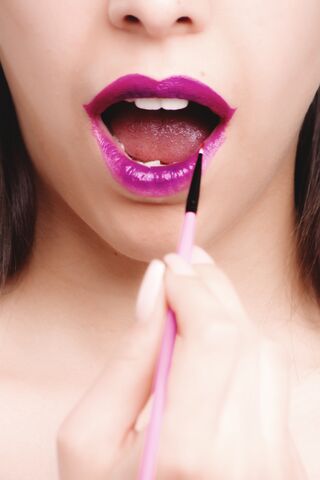Beauty
The Ugly Truth Behind Beauty Products
When looks can literally kill.
Posted May 18, 2022 Reviewed by Gary Drevitch
Key points
- From an evolutionary perspective, the cosmetics industry can be understood as helping to signal attractiveness, youth, and fertility.
- Ironically, many cosmetic products—as well as plastic surgery procedures—have harmful side effects.
- Sometimes, evolutionary adaptations to survive are at odds with adaptations that primarily benefit reproduction.

So picture this: The other night at a party, you noticed that your friend Teresa looked more radiant than usual. She dropped on you that she’s been using a new lip plumper that she totally swears by. The next day at the drugstore, you see that same product on the shelf. You notice that it has a small warning label, indicating that it might cause various autoimmune problems. Suddenly, there in Aisle 14 of your local CVS on a typical Monday, you find yourself in a potentially health-threatening bind. What do you do?
Going back to Darwin’s ideas on natural and sexual selection (see Darwin 1859, 1871), all organisms are motivated to engage in behaviors that will help facilitate successful reproduction. Without the ability to reproduce, organisms would not be able to pass their genes on to future generations. However, survival is also at the forefront of an organism's motivations. At times adaptations (qualities that help facilitate survival and/or reproduction) contradict each other. This fact makes it difficult for an organism to (unconsciously) decide whether its survival or its reproduction is, in fact, most important.
Cosmetics From an Evolutionary Perspective
We may not automatically think of evolutionary theory when we think of the cosmetics industry, but we definitely do think of altering one’s features to appear more attractive. And the reasons as to why some features are considered especially attractive over others are rooted in evolution. Cosmetics can do things such as smooth skin and plump lips, which are indicators of a woman’s fertility (Geher, 2014). Although it occurs at an unconscious level, the reason why people, men in particular, find these features enticing is because they signal that a woman is likely capable of reproducing (in light of the fact that a woman’s reproductive window is constrained in our species).
The cosmetics industry is a multi-billion-dollar industry that makes most of its money from women (Buss, 2017; Elyukin & Geher, 2019)—especially older women. Cosmetic advertisements promise to make you appear younger with the use of certain products. If anti-aging creams and serums can magically “erase wrinkles” or “take 10 years off,” women may be influenced to purchase the products. In a society that values youthful beauty while concurrently shaming women for showing signs of aging, how could you blame them? With aging comes menopause, a phenomenon associated with the end of reproductive viability in one’s lifespan. Males are, generally, less likely to pursue a woman who looks like she’s in this post-menopausal phase of the lifespan (Buss, 2017). To combat the physical effects of aging, women use cosmetics as a way to make themselves appear younger and, therefore, fertile.
Perhaps surprisingly, many of the cosmetic products we use have detrimental effects on our health. Lip plumper is just one example. Maia (2017) explained how this product makes the lips look fuller, thicker, and redder with blood circulation-enhancing ingredients. These substances work by irritating the skin on the lips, making them swell slightly and appear redder, because of the dilatation of the blood vessels. If used too often, they may cause lips to peel or even develop ulcers. People who are prone to allergies are more likely to have a strong reaction to the ingredients in a lip plumper, which may cause pain, stinging, and even a rash. Users of this product are knowingly inflicting an irritation on their skin in order to get the short-lasting effect of fuller lips.
Plastic Surgery From an Evolutionary Perspective
Women also undergo cosmetic procedures to make themselves appear fertile. An hourglass figure (i.e., narrow waist and wide hips) is another indicator of a woman’s fertility (Singh, 2006), which is why some women spend tens of thousands of dollars to attain this particular body shape. Once women reach menopause, their hips begin to narrow, similar to the way a prepubescent girl’s hips appear. Narrow hips are an indicator that a woman is unable to reproduce. Surgeries such as the Brazilian butt lift can make the hips rounder and more voluminous (Del Vecchio & Dayan, 2019), enhancing the hourglass shape and, thus, making the woman more attractive to potential male mates. A woman’s waist-to-hip ratio plays a significant role in mate selection, as it is a marker of fecundity and health (Singh, 2006). Singh (2006) conducted a study in which participants were shown 12 drawings of female bodies. Results found that women with a waist to hip ratio of about .7 were considered the most attractive, which is in line with the hourglass body shape.
Cosmetic procedures have been shown time and again to pose a threat to one’s life. Fat transplant to the gluteal region (the Brazilian butt lift) has become the fastest-growing plastic surgical operation (Del Vecchio & Dayan, 2019), doubling in growth over the past five years. The popularity of this procedure is presumably due to primal signaling that a woman with larger hips and buttocks is young and likely fertile. The lift is also the most deadly plastic surgical procedure, with a 1 in 3,000 fatality rate (Del Vecchio & Dayan, 2019), significantly higher than any other procedure of its kind. As is the case with lip-plumping cosmetic products, the beneficial, attractiveness-based results are of the short-term variety. Women who opt for this procedure need to continue getting injections every few months to keep up their appearance. A broad array of adverse health consequences have been documented in connection with this particular procedure.
Weighing the Evolutionary Costs of Survival vs. Reproduction
From the outset, evolutionary concepts such as natural selection have been deeply rooted in math (see Geher, 2014). Natural selection, for instance, is largely focused on probabilities—with the idea that features of organisms that are more likely to cultivate survival and/or reproductive success are also more likely to be retained in populations of organisms relative to features that are less effective at facilitating survival versus reproductive success.
From this mathematical perspective, it is interesting to think about cases in which some feature might lead to an increase in the probability of survival at a cost to reproduction, or vice versa. At the end of the day, Darwin’s real bottom line is reproductive success (see Trivers, 1985). That is, qualities that facilitate the ability to effectively reproduce should, by simple mathematical reasoning, be more effective at cultivating features of organisms that characterize future generations relative to features that facilitate survival only. When it comes to evolution, features of organisms that increase reproduction will ultimately outcompete features that facilitate survival (other things equal; see Geher & Wedberg, 2020).
In the cases of the cosmetics and plastic surgery industries, people are often faced with dilemmas that pit the two most critical Darwinian concepts right up against one another. If a cosmetic product increases attractiveness and, thus, potential reproductive success—but does so at a potential cost to one’s survival (by introducing adverse health consequences)—we’ve got a problem.
The fact that the cosmetics and plastic surgery industries are each multi-billion-dollar industries is particularly telling. In short, this tells us that motives to succeed in the sphere of reproduction are so profound that many people choose looks over health when they are faced with what may seem like mundane decisions in the cosmetics aisle of their local CVS. Think about that.
Bottom Line
Evolutionary forces such as natural and sexual selection favor qualities that cultivate survival and/or reproduction. But at the end of the day, reproductive success truly is Darwin’s bottom line. For this reason, people (like so many organisms) often might engage in behaviors that have potential adverse consequences in terms of survival with potential benefits when it comes to mating and reproduction.
Of course, since most people haven’t taken coursework in evolutionary psychology, their purchases of cosmetic products on any given day may well be unwittingly “choosing” attractiveness (and other mating-relevant outcomes) over health and survival.
The next time that you consider purchasing some cosmetics products or look into some kind of cosmetic procedure, think about the costs and benefits in terms of your health relative to your ability to appear more attractive. Simply being aware of this broader issue may well help people make relatively healthy decisions when it comes to ways to improve their appearance.
Note: This post was co-written with SUNY New Paltz psychology student, Darcy Montana, who will start a graduate program in mental health counseling at Baruch College in New York City in the fall.
References
Buss, D. M. (2017). The evolution of desire: Strategies of human mating (Revised edition). New York, NY: Basic Books.
Darwin, C. (1859). On the origin of species. John Murray.
Darwin, C. (1871). The descent of man, and selection in relation to sex. John Murray.
Del Vecchio, D., & Dayan, E. (2019). To ban or not to ban “Brazilian butt lifts?” Plastic surgery, responsibility, and the public health. Plastic and Reconstructive Surgery, 144(5),
952-953.
Elyukin, N., & Geher, G. (2019, December 16). Consequences of Beauty. Psychology Today.
Geher, G. (2014). Evolutionary psychology 101. Springer Publishing Company.
Maia, J. I. B. (2017). Innovation in Cosmetics–innovative makeup products: efficacy and safety (Doctoral dissertation).
Singh, D. (2006). Universal allure of the hourglass figure: An evolutionary theory of female physical attractiveness. Clinics in Plastic Surgery, 33(3). 359-370.
Trivers, R. (1985). Social evolution. Menlo Park, CA: Benjamin/Cummings.




